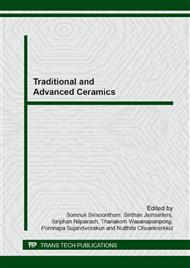p.73
p.79
p.85
p.91
p.97
p.103
p.108
p.114
p.122
Effects of Waste from HDPE Catalyst Process on Melting Behaviour and Thermal Properties of White Opaque Glazes
Abstract:
Polyolefin catalyst wastes have been rising with growing high density polyethylene (HDPE) demand. Utilizing on recycling such waste residue has then become a challenging task to achieve. Due to its relatively fine particles, iron oxide-free and consistent composition, the waste can possibly be another alternative for ceramic glaze raw materials. This study observed the replacement of the waste to the conventional glaze raw materials. The residue mainly contains TiO2 along with CaO, Al2O3 and a small amount of chloride. Physical and chemical properties of the waste were characterized. The roles of the waste on melting behaviour and appearance were observed. Colour of the introduced waste-containing glaze was determined by a spectrophotometer. Finally, coefficient of linear thermal expansion of the obtained glazes was done by a dilatometer. Characteristics of the waste-bearing white opaque glazes were reported and discussed.
Info:
Periodical:
Pages:
97-102
Citation:
Online since:
April 2014
Price:
Сopyright:
© 2014 Trans Tech Publications Ltd. All Rights Reserved
Share:
Citation:


